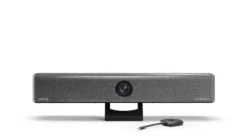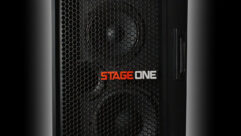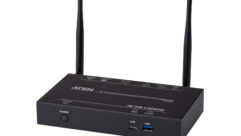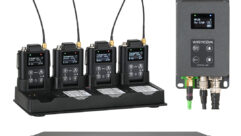
CAD WX Series Wireless System Review
Mar 14, 2013 3:17 PM,
Reviewer: John McJunkin
A good value for a gooseneck transmitter and receiver.

There are numerous applications for which a contractor would want to specify a single desktop or podium gooseneck stand with an integrated wireless transmitter. There are plenty of highly sophisticated solutions that ship with a dozen or more transmitter/microphone units, a base station, and featuring advanced AEC and other signal processing, but sometimes just a single transmitter/microphone pair and single receiver are all that’s necessary to get the job done. Then the decision comes down to price versus performance. Indeed, there are several manufacturers that make a single mic/single receiver combination, so we’re given the welcome option of shopping for value.
CAD recently introduced its WX160A transmitter/gooseneck stand to accompany its WX100 receiver, and this solution cost less than comparable products on the market. Profitability and providing reliable solutions are both key issues for contractors, so I evaluated a pair with an eye toward each. In a perfect world, we get excellent quality for a low price. Bearing this in mind, I was pleased with the CAD system.
The WX160A transmitter/gooseneck stand is housed in an enclosure shaped like a lopped-off and inverted boat hull. It’s just over 5in. in length, 4in. in width, and about 1.5in. in height. There are two primary operation buttons; the front-most of which is a momentary-contact talk button and behind it is a maintained contact lock switch, which opens the microphone until it is pressed a second time, as implied. There is a small black strip of plastic between the two, providing a frame of reference for the user without the necessity of being able to see the buttons. Toward the rear is a transmitter control segment with an LCD display and three small navigation buttons. The other segment at the rear top of the unit features the XLR jack that accommodates a gooseneck microphone. A small red power indicator is positioned at the upper right in relation to the mic jack. On the rear panel are a power button, gain knob, “failsafe” XLR mic output jack (that also doubles as an auxiliary input), DC power inlet jack, and slider switch that toggles between NiMH rechargeable and alkaline non-rechargeable battery operation. A black rubber cap is available to cover the entire rear panel except for power button for a clean look. The underside of the unit features a door to the battery compartment, which holds two AA cells.
The WX160A is intended for use with CAD’s 910B, 915B, and 920B mics, which can operate on the 6VDC phantom power provided by the base unit. The second two digits in the numeric part of the mics’ designation indicate their length. The 10in. mic shaft is a fully actuated gooseneck, and the longer two have a rigid section between actuated sections at top and bottom, hence all three are easily positioned where the user wants them. All three are cardioid condenser mics, with a relatively flat frequency response from 150Hz to 20kHz.
The WX100 receiver is roughly 8in. wide and 1.75in. tall, facilitating the rackmounting of two units side by side. The enclosure is just over 5in. deep. The front panel features a rocker-style power switch, two small pushbuttons to change channels, a level knob, and LEDs to indicate antenna diversity, RF signal presence, and audio signal presence. There is also a bright blue two-digit LED numerical display showing the current channel being received. The power switch also has a blue LED to indicate that the unit is powered on. The simple rear panel sports two antenna jacks, a DC power inlet jack, XLR balanced, and 1/4in. unbalanced audio outputs. There is also a small slot to adjust the receiver’s squelch threshold with a tweak-tool.
Deployment of the system was very simple and easy. I attached the two included antennae and then I provided power to the WX100 receiver and cabled its output to a mic input at my mixer. I set the receiver to channel 01, and then connected to the WX160 base to the 920B mic that was sent for evaluation. I confirmed that the base had two batteries, and then pressed the power button on the rear of the base. It powered on and “woke up” in lock mode, with the mic open and ready for business. I pressed the lock button to put the unit back into momentary mode. I set the transmission frequency to channel 01, and almost immediately the RF indicator on the receiver illuminated. Then the audio signal present indicator illuminated as I spoke into the mic while pressing the talk button. The unit’s wake-up mode can be changed from mic on to mic off with the front-panel controls.
I was very pleased with the quality of the audio—the CAD mics are very transparent, considering their price. They’re not dead quiet, world-class mics with perfectly flat frequency response, but they are very good for such typical gooseneck applications as boardroom, courtroom, and podium. One minor issue is that due to its directionality and proximity effect, it’s a bit susceptible to plosives up close. Users will need to be made aware that a few inches distance from the mic is in order. Otherwise, it really does sound very good, as does the RF transmission—very clean and solid. I evaluated it all the way out to 100ft. with multiple intervening walls and heard absolutely no signal degradation whatsoever; it sounded the same as it did just a few feet away and with line-of-sight.
The system overall is very easy to use, sounds very good, and is very reasonably priced. It has some useful additional touches that increase its value, such as the fail-safe hard-wired XLR jack at the rear of the transmitter, just in case there’s some kind of RF catastrophe and the show must go on right away. The system’s 16 channels should be adequate for most business, house-of-worship, or government applications for which only a couple of microphones are necessary.
If a fully appointed conferencing system is what you need, you may want to examine other possibilities. If you just need one or even a small handful of good quality wireless gooseneck mics for podium or boardroom-type use, the CAD WX system is a very good value and worth consideration.
PRODUCT SUMMARY
Pros: Good quality, great value for the money, some useful extras.
Cons: Somewhat susceptible to plosives at very close range.
Applications: Boardroom, courtroom, government, podium, house-of-worship
Price: $379(WX160A); $338 (WX100); $169(915B/920B)
SPECIFICATIONS
WX160 with 915B/920B mics:
Operating principle (915B/920B): Condenser
Polar pattern (915B/920B): Cardioid
Frequency response: 150Hz-15KHz
Maximum SPL: 118dB
RF transmitter output: 50mW maximum
Modulation: FM, ± 40KHz peak
Dimensions: 1-15/16″x22-3/16″x5-13/16″
Net weight: 1lb 6.8oz (0.65Kg mass) (without batteries)
Power requirements: 2 AA alkaline or rechargeable
Battery life:>10 hours (alkaline)
WX100:
Maximum Output Level
Balanced output: -10bBV
Unbalanced output: 10dBV
Output impedance
Balanced output: 200Ω
Unbalanced output: 100Ω
RF bandwidth: 38.4MHz
Switchable frequencies: 16
RF sensitivity: 95dBm >75dB S/N
Image rejection: >85dB
Squelch: Noise squelch and tone squelch
Multipath mitigation: True spatial diversity
Dimensions: 7-7/8″x5-7/8″x1- 3/4″
Net weight: 1lb 5oz (0.6Kg mass)
John McJunkin is the principal of Avalon Podcasting in Chandler, Ariz., and produces and co-hosts a top-rated morning radio talk show in Phoenix. He has consulted in the development of studios and installations and provides high-quality podcast and voice production services.










